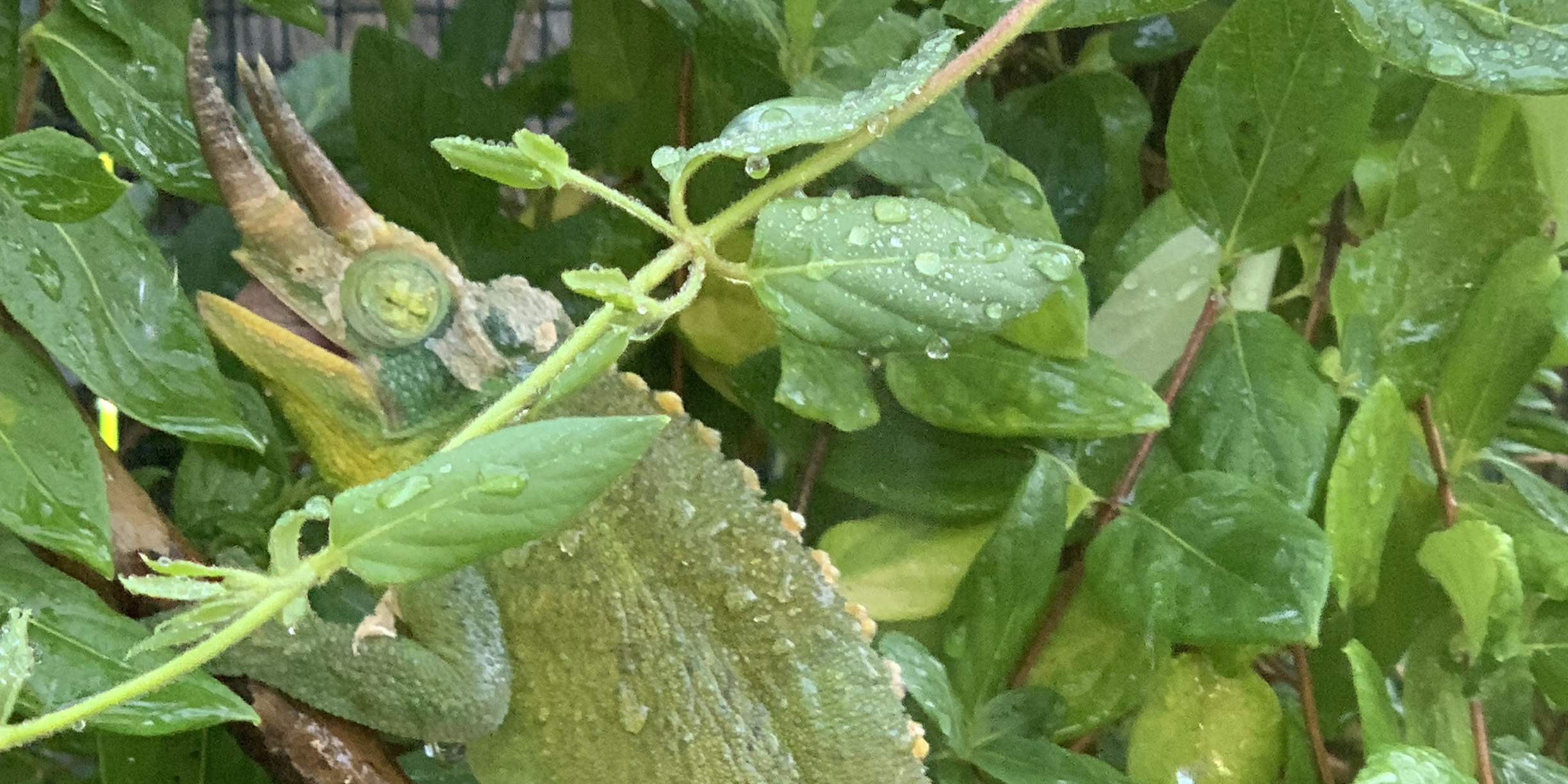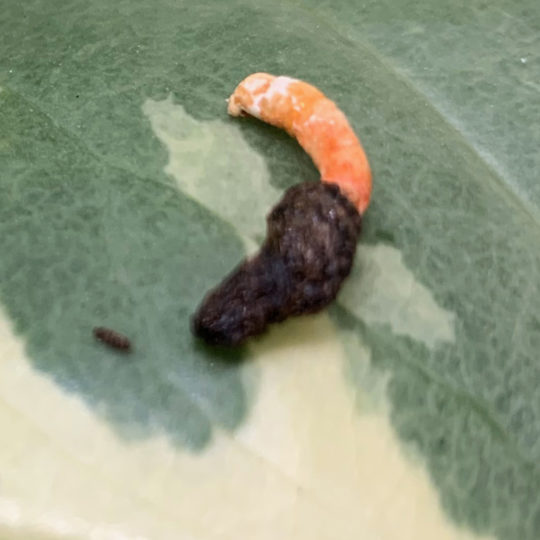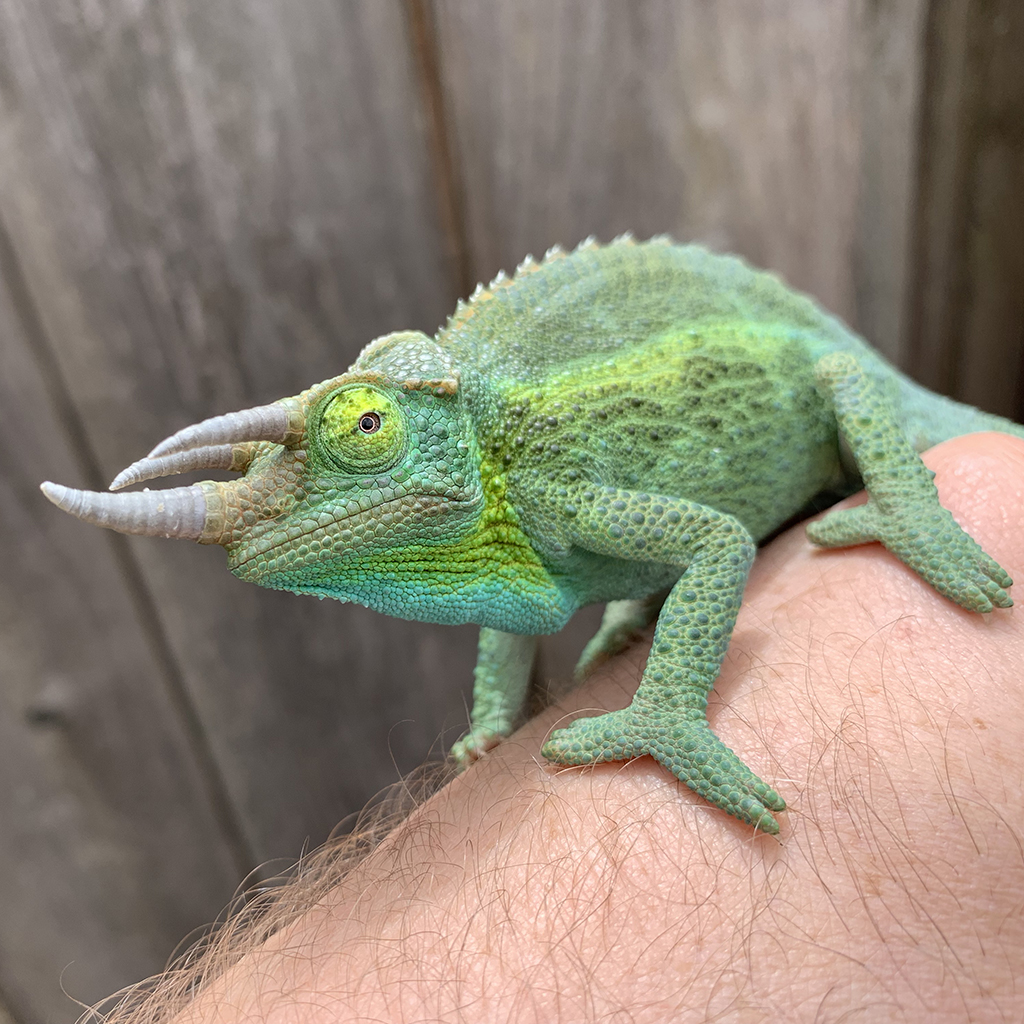Summary: Hydration
Properly hydrating your chameleon is one of the most important parts of chameleon husbandry. Life in the trees presents us with a challenge when we are trying to figure out the best approach. I will be giving an overview of chameleon hydration
- Chameleons get water from dew, food items, and rain
- The natural humidity cycle is high in the night and lower during day
- Constantly wet surfaces encourage bacterial, fungal, and mold growth
- Automatic misting system is best single hydration tool
Embedded Podcast Player: S8 Ep8 Chameleon Hydration and Drinking
How Chameleons Drink in the Wild

In the wild, chameleons get their hydration from humid nights, rain, dew left in the morning, or from their food items. There have been reports of chameleons drinking from puddles of water, but being on the ground is not a daily hang out for chameleons. Reasons chameleons find themselves on the ground can include egg laying, looking for a mate, losing a dominance battle, or that you are a Namaqua Chameleon and there are no trees in the Namibia desert. For the vast majority of species, certainly every one currently available in captivity, daily hydration needs to be done up in the trees.
Although some chameleons do come from areas that receive high amounts of rainfall, they often have distinct wet and dry seasons. As an example, Veiled Chameleons come from an area that sees a very wet rainy season and then a harsh dry season. Jackson’s Chameleons come from an area that has two wet and two dry seasons. So chameleons have had to adapt to time periods of scarce water. And, chances are, the curious case of the outlier Namaqua Chameleon, that traipses across the sand dunes in a rebellion against what we think of for chameleons, could offer some clues in our overall quest.
A Natural Chameleon Hydration Cycle

A good place for us to start in understanding hydration is to look at the seasons in a chameleon’s life. This is tricky because, as stated before, there are wide seasonal fluctuations. So the first question we have to answer is which part of the year will we replicate. We in the chameleon community have traditionally followed a “perfect day” model where we identify the best husbandry to our current understanding and give that to the chameleon 365 days a year. This has worked well for us, but we have come far enough that it is time to explore introducing seasonal variations. So, more and more, you will see care guides that have wet and dry season parameters. You will see a lot more exploration of the dry season parameters here on the Chameleon Academy, but a good place to start with chameleon husbandry is the Perfect day model. And, you will find that the model I have compiled to be a hybrid between wet and dry season conditions. Neither the drenching of the rainy season, nor the harsh, life threatening desiccation of the dry season are desirable to our current understanding. So, the following hydration-themed day-in-the-life takes the best of the natural conditions from the wet and dry seasons. This idealized hydration cycle is designed to give you, the keeper, a model which will provide for your chameleons a natural style hydration with the most efficient use of water.
Hydration Philosophy
In captivity we strive to replicate the natural process as much as is possible. We want to provide the necessary components, but remove the unnecessary stress points. The trick is figuring out what is depended upon and what is challenging the tolerance zone.
To dive into how we will recreate this we will have to know the tools we have to work with. There are a number of hydration tools, but, unfortunately, I can’t say that I think we have the perfect equipment. So there definitely is room for the budding chameleon enthusiast entrepreneur to create products. But, let’s review what we have available to us right now.
Chameleon Hydration Equipment
Misting systems
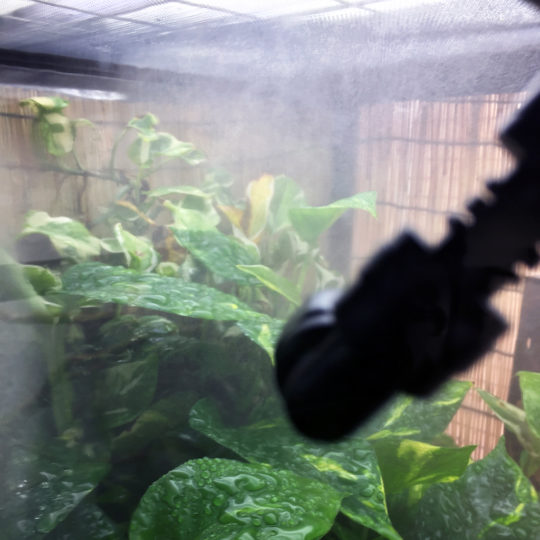
The most common method of Chameleon hydration is misting.
Misting can be anything from a simple hand mister to a high end automatic misting system. Misters send a fine mist spray into the cage and coat the leaves with water. From here the chameleon will drink the misting off the leaves. Automatic misters are the hydration tool of choice because they give both the dew on the leaves and are able to be automated so you can run them, not only for an afternoon rain shower, but during the night for a morning layer of dew, while you are sleeping, at work, or are away on vacation. The automatic nature of the misting systems ensures that water is reliably available for your chameleon.
The downside to a misting system is that water is shot out under pressure. This is not comfortable to any chameleon in close proximity and, like any animal that is blasted with water, they will run away.
I usually use misting during the night in conjunction with fogging to have the chameleon wake up to a wet world. Since they are sleeping, usually in a protected area, they are not being blasted by the mist. My day hydration is often done with drippers. I will use the automatic misters only if my cage is set-up in a way that the chameleon does not get blasted by the mist in their favorite daytime perching spots. And there are ways to replicate an afternoon rain shower using light dimming to warn the chameleon that the spray is about to start. They actually learn pretty quickly what the signs mean!
One must note that the fine mist nozzles are prone to clogging if you run hard water through the system. This is water with high amounts of dissolved minerals such as calcium. This is often the case with tap water. For best operation use Reverse Osmosis or distilled water with your misting system. Some concerns in the community have been raised over distilled water leeching minerals from the body, but there has yet to be a demonstration of this as a practical concern within chameleon husbandry. Anything from tap water to RO to distilled water has been used without issue so you may choose the water type of your choice. I, personally, have used standard drinking water available from water stores for my indoor chameleons for many years and it has worked well.
Fogger (or ultra-sonic humidifiers)

We often focus on daytime hydration because we don’t think about what goes on at night. But an in-depth conversation regarding Veiled Chameleons in Yemen on this podcast with Petr Necas introduced me to the concept of foggy mornings being an important component to hydration. A basic search turned up a scientific study showing how Anole lizards (anolis) lose moisture through their breath just like humans. This jogged me into thinking about how this could explain why chameleons seem to drink so much in captivity when they do not have access to such water in the wild. The idea is that a foggy early morning, like they have in their homeland, reduces their dehydration during the night and is being evaluated as a possible hydration source. If you were listening to this podcast in 2018 and 2019 you would have been able to trace my exploration from the original interviews with Petr Necas about the natural condition in Yemen to my testing in my own collection to interviewing Mario Jungmann on his years of experience with fogging. We still have much to learn about fogging and chameleons, but at this point I believe it to be an important tool to recreating the naturalistic hydration cycle. I am sure it is no surprise that I will continue to work with fogging to figure out what it can do for us and our chameleons.
It is useful to know that fogging has become a highly politicized subject in the chameleon community. You will encounter everything from strong opinions that it should be the only hydration method to people who insist fogging will kill your chameleon. As you might suspect, there are scraps of truth in all those arguments, but not a full picture. Fogging as been shown to be an effective hydration technique by chameleon keepers and replicating a natural rise in humidity at night is an obvious component in replicating the natural environment. But fogging is only a tool and our use of it is limited by the equipment we have available. Foggers, like anything dealing with water, must be kept clean to avoid health issues. We need to take bacterial issues seriously, but that is a discussion about cleanliness protocol, not the validity of high humidity nights as a husbandry consideration.
For more details on fogging there is a detailed discussion page, Fogging For Chameleons. Click the image below for the link.
Drippers
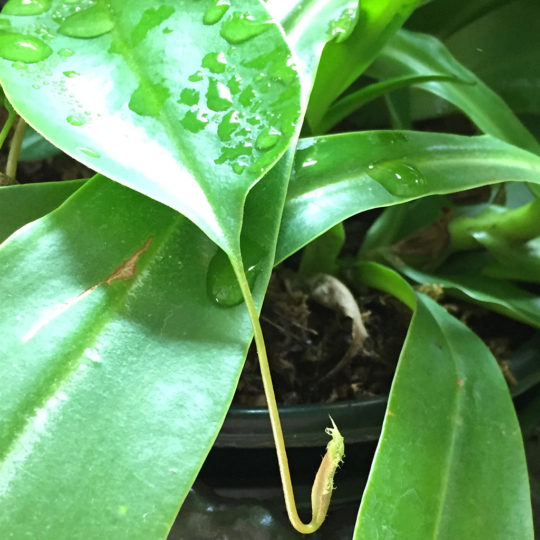
A simple hydration method is the gravity feed dripper. These can be as easy as poking a pin hole in a party cup to purchasing an inexpensive reptile dripper that has a water reservoir and a valve for controlling drip rate. Drippers are an excellent back-up and staple hydration method. They do not have the sudden, scary turn-on factor like misting systems and they provide a constant source of water on the leaves that the chameleon can find whenever it is thirsty. You will need a drainage collection tray of some sort to collect the excess water at the bottom. Do not let it pool as it could easily become a health hazard.
Cleanliness note
Whether mister, dripper, or fogger or anything else dealing with water, be careful to keep all parts clean. Misters will spray the entire cage with dirty water and foggers will aerosolize whatever is in the water basin. Make sure your equipment is cleaned on a regular basis.
Other Hydration Methods
There are other hydration methods such as pipettes, drinking glasses, or fountains. I do not deal with those as they are treating hydration in an unnatural manner. Although they can get water into the chameleon they are also methods that won’t work effectively on all chameleons. When we have to train the chameleon or force the chameleon to do something unnatural to survive it is, philosophically, going down the wrong direction. There is nothing inherently wrong with any hydration method which gets water into the chameleon, but to limit the hydration strategy to an unnatural method is relegating your chameleon to live in the tolerance zone instead of in an ideal husbandry situation. That is not what we do here.
You may hear something about taking your Chameleon into the shower for a weekly douse. Showers are often used for emergency hydration situations. Hopefully, you are not in this situation and you should have the cage set so they get all the hydration they need in the cage. So, in the standard chameleon husbandry you shouldn’t have to use a shower.
Another practice you need to be on the watch for is soaking your chameleon. There are some vets that are not experienced with chameleons that will tell you to soak your chameleon in a bowl of water. This is not effective to hydrate a chameleon and will cause undue stress. If your vet is directing you to soak your chameleon then it is time to consider another vet. They are probably qualified to do fecal exams, dispense antibiotics, and perform surgeries, but do not take husbandry advice from them and it is worth it to stand up for your chameleon and not let them be soaked. This is a practice taken from other reptiles and is not only not effective for chameleons, it is highly stressful.
Sample Hydration Schedule
Let’s start by going through that generalized day in the life with a focus on what is happening
When night sets, and the chameleon sleeps, your chameleon will lose moisture through breathing. The more humid the air the less moisture is lost. As the night goes on, the humidity rises until fog rolls in. The air is moist and, as the temperature falls past the dew point, the moisture condenses into dew on leaves. They are breathing in moist air throughout the early morning greatly reducing the dehydration during the night. When the chameleon wakes up they can lick the dew to complete their rehydration if necessary and start their day. If this is the rainy season then there will be rain and more water than the chameleon can want. But if it is the dry season, when it is months between rain, then the chameleon will maintain hydration from the fog, dew, and the moisture found in its food.
To replicate this Perfect Day cycle we use misters to lay down the dew and a fogger to create our fog. Sometime after midnight, in the cool of the night, we simulate the rolling in of a fog bank. The actual hour doesn’t matter, but I start my fogging around 1 or 2AM. I will then keep the fog bank going until right before the lights come on in the morning. I bracket the fogging session with a short misting of about 30 seconds before the fog starts to prime the cage surfaces. The fog from the ultrasonic humidifier tends to roll off dry surfaces and flow out of the cage. But if we lay down a layer of dew the fog tends to stay around. By having the mister and fogger going at the same time there is a potent mixture of humidity. We only need the mister to lay down a layer of moisture. We do not need a drenching so the mister goes for only the first 30 seconds of the fogging session. The fog will continue until just before the lights come on. Note than you can have the fogger going 30 minutes on and 30 minutes off until the morning lights come on. If you are in an environment with high relative humidity to begin with it may not take constant fogging to keep the fog bank replication going. Just remember the fogger is your tool, it is not the end requirement. Each one of our tools will have to be used differently in different environmental conditions.
Right before the lights come on the misters will activate again for a minute or two and reinforce that layer of dew on cage surfaces. When the lights come on, the chameleon wakes to a world covered in dew and can complete any necessary hydration to start the day .
And this is usually all the hydration a chameleon needs.
Now, I always like to include a test to make sure everything is going well. And I use two tests to verify hydration. The first is the poop test. And this is simply whether the poop has an acceptable level of moisture. If the poop is moist then the chameleon is getting enough hydration.
A second way to measure hydration levels is in behavior. Generally speaking, we don’t like seeing our chameleons drink because that means our methods aren’t working as well as we would like. So, I often like to run a dripper in the late afternoon and observe the behavior. A thirsty chameleon will go over to the drip and drink. A hydrated chameleon will ignore the drip or will play around by shooting its tongue at the water droplets. If there would be a time the chameleon was dehydrated it would be in the late afternoon after basking and a day of hanging out. If their poop is moist and they ignore water in the afternoon then you have your answer.
One may immediately notice that there is no misting during the day in this naturalistic hydration method. Wouldn’t it replicate the natural condition during the rainy season to have multiple mistings during the day. While that is true, chameleons hate being sprayed with water. Add that to the hygiene challenges when you have constantly wet surfaces and it is worth critically evaluating replicating the wet season conditions. And if full hydration can be obtained without excessive “raining” during the day then we don’t need to do it until we find a link to a health or psychological need.
The said, there may be a use for you to implement an afternoon rain shower. Perhaps you are having trouble figuring out the right hydration balance. Perhaps you want to experiment with the benefits of having more rainy season elements. Whatever the reason, there is a way to warn the chameleons that a rain is coming. You can simulate a coming cloud cover by turning off some or all the lights. I also will start the fogger about a minute before starting the misters. All of these are signs your chameleon will quickly recognize as a prelude to the misters coming on and they will be able to decide how they want to handle the coming afternoon rain shower.
Air Movement & Drying out the surfaces!
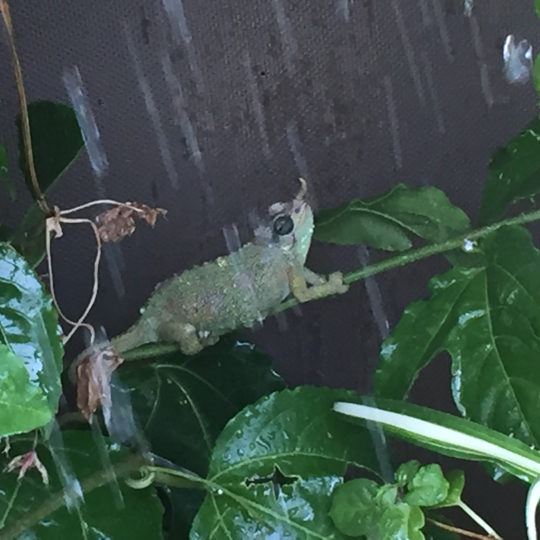
And discussion about humidity must include a discussion about air flow. The more the ambient humidity in your room matches what you are trying to achieve for your chameleon, the more you can use screen cages. If you are trying to keep a chameleon in a dry environment and you want to maintain a 50% Relative Humidity during the day and spiking up to 100% during the night, then you will have to have a solid sided cage. In fact, a hybrid cage which has all solid sides except vents in the lower front and a screen top is usually the ideal cage for most cases.
Stagnant air is a health risk and so those vents are critical. The vents in the lower front and the screen top create the chimney effect for air circulation. This is where air warmed by the lights rises through the top screen and pulls cool air from the bottom vents. This airflow provides air exchange while allowing humidity to be kept in. If more circulation is necessary, computer fans can be used. Have them blowing across the top of the cage or mounted on the cage blowing out. We want air exchange, but not a constant draft on the chameleon.
The fan action can be automated and turned on a couple times a day. During fogging is a good idea and maybe in the afternoon to make sure all the surfaces dry off.
On care guides you will often see a daytime humidity drop recommended. This is to help with our cage conditions. We do not want constantly wet surfaces because we don’t want to encourage bacterial, fungal, and mold growths. The way we combat that is to make sure cage surfaces dry sometime during the 24 hour period. To do this we use a humidity drop during the day which follows what would happen in nature. This is a reversal of the older way of making the cage dry out during the night and misting multiple times during the day. Dry nights and wet days are the opposite of what happens in nature so switching that practice should be a no-brainer.
But us lowering humidity during the day to 50% or even as low as 30% should not be morphed into saying that chameleons need this daytime drop in humidity. Just walking through various places in Madagascar and you learn the humidity doesn’t necessarily drop that low during the day. This daytime humidity drop is for us to be able to maintain a hygienic environment in a situation where we have to keep in humidity to maintain a healthy environment.
Measuring the hydration of your chameleon
So how do you know if your chameleon is hydrated or not? It is actually pretty simple. If you chameleon appears healthy – meaning alert eyes, hunting food, and pooping – then you can tell if they are dehydrated by how they act when you set a dripper to drip on leaves right by where they are. If they rush to the water and gulp then they are dehydrated. If they look at the drip of water indifferently then they are hydrated. We discussed adding a dripper in the afternoon to see if the chameleon was thirsty enough to go drink from it. The other method is to look at the poop.
Urates
Urates are the white and orange part of the poop that comes out with the dark brown tightly packed bundle. Urates give us a view into hydration because they start white and as they go through the intestines, the body reclaims moisture from them. This turns the urates orange. Thus the thought is that if the chameleon’s body is completely hydrated it will not reclaim any moisture from the urates and the end result is a 100% white urate. This is reasonable logic, but our logic must be checked with natural observations. Although, it is exceedingly difficult to get a herpetologist who is studying poop in the same place as a pooping wild chameleon.
Some information we have comes from Petr Necas who is one of the rare world travellers that looks for pooping chameleons. He notes that healthy wild chameleons have up to 50% of their urates orange. Thus, observations suggest that those seeking to replicate the natural balance would strive for some orange in the urate.
I take special pride in the distinction of being the one credited with making Petr Necas take pictures of wild chameleon poop. We all have our claims to fame and that is mine. (You know, you would think there would be some kind of medal that comes with that.)
Eye washing
There was a hypothesis that chameleons used rain to wash out their eyes. I make special note of this because on my podcast I was a vocal proponent of this idea. I saw eye health benefits from showering my chameleons. But it always bothered me that chameleons never seemed to want to be in the rain. They always ran away. This is not the behavior of an animal that needs rain for critical health maintenance. So you may hear in the community that showering and misting is necessary for eye health. I do not have the final answer. But I am bothered enough by the story not fitting together cleanly that I have backed off speaking about it. There is a fair chance that the benefits I believe I observed connecting eye health and misting were actually caused by an increase of vitamin A in both my and other keepers’ chameleons. I continue to investigate and talk with scientists, vets, and naturalists and will update my writings as more is learned.
At this point, in my personal husbandry, I avoid showering my chameleon for either drinking or washing eyes out. I use mist heads extensively and I do spray down my outside cages. So they are subject to periodic “rain showers”. But my target strategies for hydration focus on getting leaves wet instead of ensuring the chameleons get wet.
I have not experienced a return of eye issues since changing to a no-showering husbandry strategy.
Do We Need to Know more about Chameleon Hydration and Drinking?
Now, this all is a lot to take in. And, some of the information above is relatively new. As exciting as discovering new things is, it is a valid question to ask, “do we really need to know more than what we already know?” Currently, the technique used by most of the community is an automatic mister sprayed a number of times through the day. It seems that the standard misting system provides water in a way that produces moist poop. Do we really need to go further into hydration if we have already found a method that produces a hydrated chameleon?
And the answer is, yes, it is always worth it to figure out their most natural method of getting what they need in the world. The reason why is that they have developed to hydrate a certain way. To force them to hydrate differently adds stresses. Chameleons will do whatever it takes to survive, but adaptation to a foreign method should not be considered a substitution for a natural method. There are compromises we have to make in captivity, but we should not bind ourselves to them willingly and we absolutely should not decide that a non-natural way is the end of our research into chameleon husbandry. Well, isn’t everything we do unnatural? And, the answer is kind of. But it is our decision how much we want to use that as an excuse to not get closer and closer to their wild condition. This is not a black and white situation. The closer we get to fulfilling their needs in natural ways the closer we get to ideal husbandry. If you were to define ideal husbandry I would say our goal would be to replicate their needs in as natural of a way as possible and remove the unhealthy stresses. And even that is not black and white. What if some stresses might be threatening, but also the chameleon has grown dependent on them? I fully expect this to be a life long journey that I will have to hand the baton over to the next generation. I make sure I am enjoying this journey because I do not expect that I will be here when we reach the mountain peak. I am going to get the next generation as close as possible, but there is a lot to still figure out. And, it tends to go slowly.
The reason I have to make this argument is that people tend to get comfortable with one method. It was the latest accepted approach when they started and they got really good at it. And after a while, they do not want to go beyond that method. And so, we have to recognize that people naturally stop looking for forward progress and settle into reasons why they don’t have to. And if you are doing the same thing you have been doing for the last ten years then that is your decision. And that is fine. You were part of establishing the foundation we have now. Everyone will stop pushing forward at some point. The only way that decision will damage the community is if you decide to resist anyone else moving forward beyond your favorite method. If you are seen as an authority then take care of those people and do what is best for them. You don’t have to understand new ways or engage with them. Just don’t be a roadblock for those who are still hungry to learn more.
And to those who are still hungry to move forward and see what we can discover that brings us closer to giving chameleons ideal husbandry know that there will be missteps and dead ends. The path forward is not a straight line, but a winding and looping trail that takes time, patience, and tenacity. It also requires a high capacity to getting it wrong, but learning the lessons so we can get closer to the end goal next time. That is how discoveries are made. And, for anything to be entered into the book of chameleon herpetoculture it needs to be repeatable across multiple keepers and breeders. But it is extremely satisfying when a significant step forward is made. I think it is worth it.
So, where do we go from here? We keep exploring and working out ways that makes what we do in captivity replicate their natural condition. The prize is a chameleon that lives its longest genetic potential. And that is what we are doing here.
Navigation
This seminar is part of the introductory course Chameleon Basics which, in turn, is a module within the even larger Term 1: Getting Started With Chameleons.

